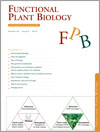
Functional Plant Biology
Volume 46 Number 8 2019
FP19018Plants and human beings engage similar molecular crosstalk with nitric oxide under stress conditions
Stress is a widespread problem in living beings – both animals and plants. Nitric oxide (NO) is involved in significant intracellular molecular interactions used to regulate stress. A number of similarities have been observed in the biochemical cascade influencing the adaptive mechanisms for relief from stress in plants and human beings.
Heavy metal intake by the plants reaches the human food chain and negatively affects human health. Therefore, it is important to inhibit its uptake by plants. With this aim, the tobacco transgenics with SbMYB15 transcription factor from Salicornia brachiata was developed which showed reduced heavy metal accumulation, increased antioxidative activity and normal growth in the presence of CdCl2 and NiCl2•6H2O.
Soil waterlogging and high temperature conditions generally occur together in the Yangtze River Valley, China, negatively affecting cotton fibre development. To examine their combined effects on fibre biomass and quality, isobaric tags for relative and absolute quantitation was used and 335 differential abundance proteins were detected under elevated temperature and waterlogging combined. Fibre development was inhibited mainly by reduced osmolyte accumulation, blocked secondary wall synthesis and a disrupted cytoskeletal system.
FP18328Photosynthetic response in wheat plants caused by the phototoxicity of fluoranthene
PSII in wheat plants is sensitive to toxic effects of fluoranthene (FLT). PSI is not affected by FLT but is inhibited by photomodified FLT (PFLT). Cyclic electron flow around PSI could protect it from low concentrations of PFLT but high concentrations of PFLT inhibited PSI by inhibiting cyclic electron flow.
Accompanying the rapid growth of the global population is the rising demand for food quantity and quality. Our study analysed the effect of inoculation with an arbuscular mycorrhizal fungus on the growth and nutrition of 15 crops. The results link the effect of arbuscular mycorrhizal fungi to crop growth, as well as nutritional uptake of the plants, which is essential to understand the practical value of these fungi in agroecosystems.
FP18318Fundamental parenchyma cells are involved in Na+ and Cl– removal ability in rice leaf sheath

Salt stress is an important abiotic factor limiting the growth and production of rice. We found that rice leaf sheath functions to exclude Na+ and Cl– from the leaf blade by sequestering them in the fundamental parenchyma cells. Results of the present study provide new insights into how rice plants reduce salt accumulation in the leaf blade using the leaf sheath.
FP19042ANS-deficient Arabidopsis is sensitive to high light due to impaired anthocyanin photoprotection
Upon high light stress, light-shielding and antioxidation are the main mechanisms of photoprotection by anthocyanin, the final key enzyme in whose synthetic pathways is anthocyanin synthase (ANS). This investigation tackled the role of ANS in photoprotection: ANS mainly regulates the light-shielding of anthocyanin in photoprotection. Additionally, we found that light-shielding is the important function in photoprotection of anthocyanins, and high antioxidant capacity cannot compensate for the absence of the light-shielding.
Chloroplasts are essential organelles for photosynthesis in plants, but they are more sensitive to low temperature than other cellular organs. The role of OsSIG2A in chloroplast development at low temperature is of great significance and cannot be replaced by the other endogenously expressed sigma factors. This suggests a new function of sigma factors in protecting plant development under low temperature.
FP18291Characterisation of a rice vacuolar invertase isoform, OsINV2, for growth and yield-related traits

Vacuolar invertase plays an important role in plant growth and development, and is an important sink strength determinant. Knockout of a vacuolar invertase, OsINV2, had no detrimental effects on growth and development, and grain and panicle-related traits despite its expression in the early panicle development stages; while the overexpression phenotype showed drastic changes in stem non-structural carbohydrate content, spikelet number and grain weight. This study provides evidence for regulatory differences of vacuolar invertases in rice.



